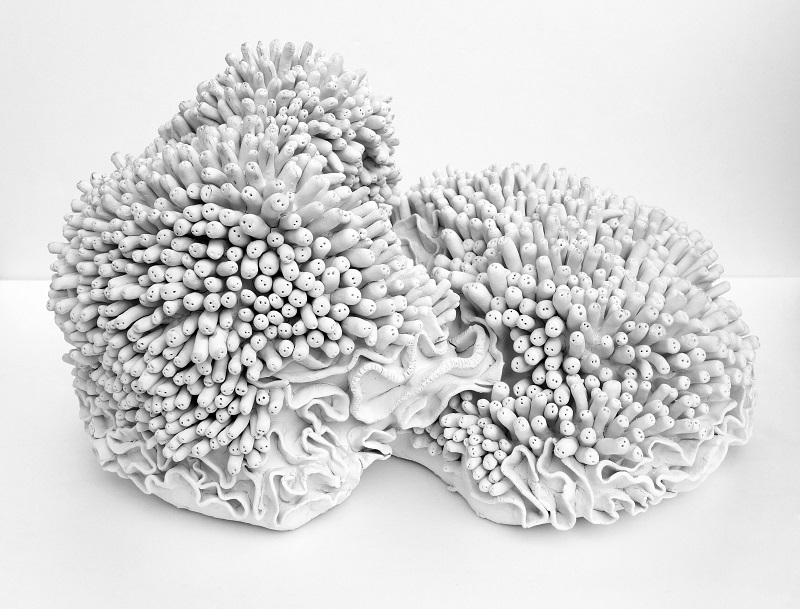CATARINA NUNES E VANESSA BARRAGÃO
29 de junho a 1 de outubro de 2023 I MU.SA


Morphosis: Catarina Nunes e Vanessa Barragão
MU.SA | curadoria e textos por Katherine Sirois
A exposição revela o encontro excepcional entre a designer têxtil, Vanessa Barragão, e a ceramista Catarina Nunes. Apesar da distinção das técnicas e dos materiais que utilizam, Nunes e Barragão criam formas biomórficas e proliferantes que refletem a sua profunda ligação às dinâmicas e expressões da natureza. Ambas as artistas abraçam uma sensibilidade e uma visão ambiental, bem como um genuíno interesse em questionar os fenômenos naturais do ponto de vista da relação indecifrável entre matéria e energia.
Na linha do movimento modernista que se desenvolveu a partir de meados do século XX, as duas artistas apropriam-se e redefinem técnicas milenares e materiais tradicionais seguindo abordagens inovadoras.
Catarina Nunes trabalha principalmente em cerâmica escultórica e instalação. Utilizando os quatro elementos primários da terra, água, ar e fogo, assim como uma grande variedade de matérias como a faiança, o grés, a porcelana, o vidro soprado, o metal e a mica, a artista cria o seu mundo de inspiração marinha, de formas orgânicas e de criaturas misteriosas, enquanto experimenta questões relacionadas com a espacialidade e a volumetria. Nunes também investiga a física dos cristais de sal que cultiva nas suas estruturas de parede concebidas como rabiscos tridimensionais. Para além da interação entre a cerâmica e a escultura, a artista também expande a sua prática para o domínio da instalação contemporânea, misturando diferentes médiuns.
À semelhança dos anteriores artistas pioneiros no campo da arte em fibra, quando romperam com o rectângulo, a moldura e depois com a parede — expandindo assim as possibilidades do médium — Barragão experimenta a volumetria, a espacialidade, a gravidade e a dimensionalidade, transcendendo o peso e os constrangimentos dos materiais. Utilizando principalmente materiais reutilizados como lã, tencel e juta, e misturando técnicas entre as quais o crochê, a feltragem, a tapeçaria esmirna e outras manipulações de fibras, a sua abordagem envolve práticas de reciclagem e reconversão de desperdícios provenientes da indústria têxtil. A produção de Barragão é alimentada pelas suas questões espirituais, para as quais procura respostas através da exploração do reino vegetal e da vida marinha.
Morphosis evidencia o modo como Nunes e Barragão expandem o respectivo campo de ação ao produzirem instalações multimédia, compósitas e interactivas, recorrendo a dispositivos originais, vídeo, gravações sonoras e sensores de movimento. Ao trabalharem com técnicas ancestrais — tradicionalmente associadas ao artesanato e às artes aplicadas — ultrapassam as fronteiras da arte da fibra e da cerâmica, ao mesmo tempo que aliam os dois campos de forma atípica e revitalizante.
Morphosis: Catarina Nunes and Vanessa Barragão
MU.SA | curatorship and texts by Katherine Sirois
The exhibition enlightens the exceptional encounter between the fibre art designer, Vanessa Barragão, and the ceramist Catarina Nunes. Despite the distinctness of the techniques and materials they use, Nunes and Barragão create biomorphic and proliferating shapes that reflect their deep connection to nature's dynamics and expressions. Both artists embrace an environmental sensibility and vision along with a genuine interest in querying natural phenomena from the point of view of the unseizable relation between matter and energy.
In line with the modernist movement, which was developed from the mid-twentieth century onwards, the two of them appropriate and redefine age-old techniques and traditional materials according to refreshing and innovative approaches.
Catarina Nunes mainly works across sculptural ceramics and installation. Using the four primary elements of earth, water, air and fire as well as a wide variety of materials such as faience and stoneware, porcelain, blown glass, metal and mica, the artist creates her marine inspired world of organic shapes and mysterious creatures, while experimenting with questions related to spatiality and volumetry. Nunes also delves into the physics of salt crystals that she grows on her wall-mounted structures conceived as three dimensional scribbles. In addition to the interaction between ceramics and sculpture, the artist also expands her practice into the realm of contemporary installation, mixing different mediums.
Like previous pioneering artists did in the field of fibre art when they first broke away from the rectangle, the frame and then with the wall — thus expanding the medium’s possibilities — Barragão experiments with volumetry, spatiality, gravity and dimensionality, while transcending the weight and constraints of materials. Using mainly reused materials such as wool, tencel and jute, and mixing techniques including crochet, felting, latch hook and other fibre manipulations, her approach involves recycling and reconverting waste from the textile industry. Barragão's production is fuelled by her spiritual questions, to which she seeks answers through exploration of the plant kingdom and marine life.
Morphosis highlights the way in which Nunes and Barragão expand their respective field of action when producing composite, interactive and multimedia installations using original displays, video, sound recordings and motion sensors. While working with ancestral techniques — traditionally associated with handicrafts and applied arts — they push the boundaries of fibre art and ceramics, while combining the two fields in an atypical an revitalising manner.
Sinopse
A exposição Morphosis evidencia ainda a forma como Nunes e Barragão expandem o seu campo de ação ao produzirem instalações multimédia, compósitas e interativas, utilizando dispositivos originais, vídeo, gravações de som e sensores de movimento. Ao trabalharem simultaneamente com técnicas ancestrais — tradicionalmente associadas ao artesanato e às artes aplicadas — e ao utilizarem materiais simples ou brutos como o barro, a areia e o vidro soprado, pigmentos naturais, lã reciclada, liocel e juta, ultrapassam as fronteiras antiquadas da arte da fibra e da cerâmica, ao mesmo tempo que aliam ambos os campos de uma forma atípica e revitalizante.
The Morphosis exhibition also highlights how Nunes and Barragão both expand their respective field when producing multimedia, composite and interactive installations using original displays, video, sound recordings and movement sensors. Simultaneously working with ancestral techniques — that were traditionally associated with crafts and applied arts — while using simple or brut materials such as clay, sand and hand-blown glass, natural pigments, upcycled wool, lyocell, and jute, they go beyond the old-fashioned boundaries of fibre art and ceramics at the same time that they blend both fields in an atypical and revitalising manner.
Catarina Nunes
As unidades individuais de argila e arenito que a artista produz, multiplicam-se e espalham-se nas paredes com um efeito proliferante, elevando assim o médium da cerâmica ao domínio da instalação contemporânea. Para além de conceber estas estruturas como rabiscos tridimensionais (desenhos volumétricos que se estendem no espaço), Nunes também complexifica a instalação através de um processo químico de nucleação de cristais que desencadeia utilizando uma solução super saturada de cloreto de sódio sobre as superfícies rugosas das cerâmicas.
Bio
Baseada em Lisboa, Catarina Nunes trabalha sobretudo em cerâmica escultórica e instalações. Licenciada em “Design - Tecnologia Cerâmica” pela ESAD-CR, e mestrado em Cerâmica Contemporânea na Tama Art University, Tóquio, Erasmus “Design de cerâmica e vidro” na UCE, Birmingham. Leciona “Projeto e Tecnologia Cerâmica” na Escola Artística António Arroio. Desde 1998, participa regularmente em exposições colectivas e individuais onde se destacam: 2020 Projeto de cruzamento entre arte e ciência (Biologia marinha), Universidade de St. Andrews, Reino Unido; “Projeto Extremophilarum” Museu da Fábrica da Baleia, Museu de Angra do Heroísmo, Açores (2021); “Trajetória(s) 100 anos de ensino artístico”, Sociedade Nacional de Belas Artes, Lisboa (2019); "Os sítios do barro" Complexo Cultural da Levada, Tomar (2019); “Melhor da Europa” Evento Homo-Faber, Veneza (2018); Bienal de Cerâmica de Aveiro”, Aveiro (2018); “Corpo e Matéria” Galeria Shiki Miki, Lisboa, (2018); “Vestígios de mar” Centro Municipal de Cultura, Ponta Delgada, Açores (2018); “Novos graus de sigilo” Sociedade Nacional de Belas Artes, Lisboa (2016); “Arte próxima” CCAM de Catalunya, Barcelona (2016); “Tulipamwe”, Galeria Nacional da Namíbia, Windhoek (2015); “Flumen” Museu de Coruche, Coruche (2014); “Ephemeral”, Setagaya Art Gallery, Tóquio (2006).
Based in Lisbon, Catarina Nunes mainly works across sculptural ceramics and installation. With a degree in "Design - Ceramic Technology" at ESAD-CR, MA in "Contemporary Ceramics” at Tama Art University, Tokyo and Erasmus "Ceramics and Glass Design" at UCE, Birmingham, she teaches “Ceramic Design and Technology” at Escola Artística António Arroio. Since 1998, she has participated regularly in collective and individual exhibitions with the highlights: 2020 Project of intersection between art and science (Marine Biology), University of St. Andrews, UK; "Extremophilarum Project" Fábrica da Baleia Museum, Angra do Heroísmo Museum, Azores (2021); "Trajetória(s) 100 anos de ensino artístico", Sociedade Nacional de Belas Artes, Lisbon, (2019); "Os sítios do barro" Complexo Cultural da Levada, Tomar (2019); "Best of Europe" Homo-Faber Event, Venice, (2018); Aveiro Ceramics Biennale", Aveiro (2018); "Body and Matter" Shiki Miki Gallery, Lisbon, (2018); "Vestígios de mar", Centro Municipal de Cultura, Ponta Delgada, Azores (2018); "New Degrees of Secrecy", Sociedade Nacional de Belas Artes, Lisbon (2016); "Arte próxima", CCAM de Catalunya, Barcelona (2016); "Tulipamwe", National Gallery of Namibia, Windhoek (2015); "Flumen", Museu de Coruche, Coruche (2014); "Ephemeral", Setagaya Art Gallery, Tokyo (2006).



